Welcome to Cancun, where the margaritas flow like water and the wildlife is just as wild!
From the crystal-clear waters of the Caribbean Sea to the lush jungles of the Yucatan Peninsula, this Mexican paradise is a haven for animal lovers of all kinds.
If you’re looking to get up close and personal with some of the local critters, you’re in luck – Cancun is home to a diverse array of fascinating fauna.
Whether you’re a birdwatcher, a marine enthusiast, or just someone who enjoys the occasional iguana sighting, there’s something here for everyone.
So where can you find these furry and feathered friends, you ask?
Well, look no further than the Sian Ka’an Biosphere Reserve, where you can spot dolphins, manatees, and even jaguars in their natural habitat.
Or head to Isla Contoy, a protected island where you can snorkel alongside sea turtles and colorful reef fish.
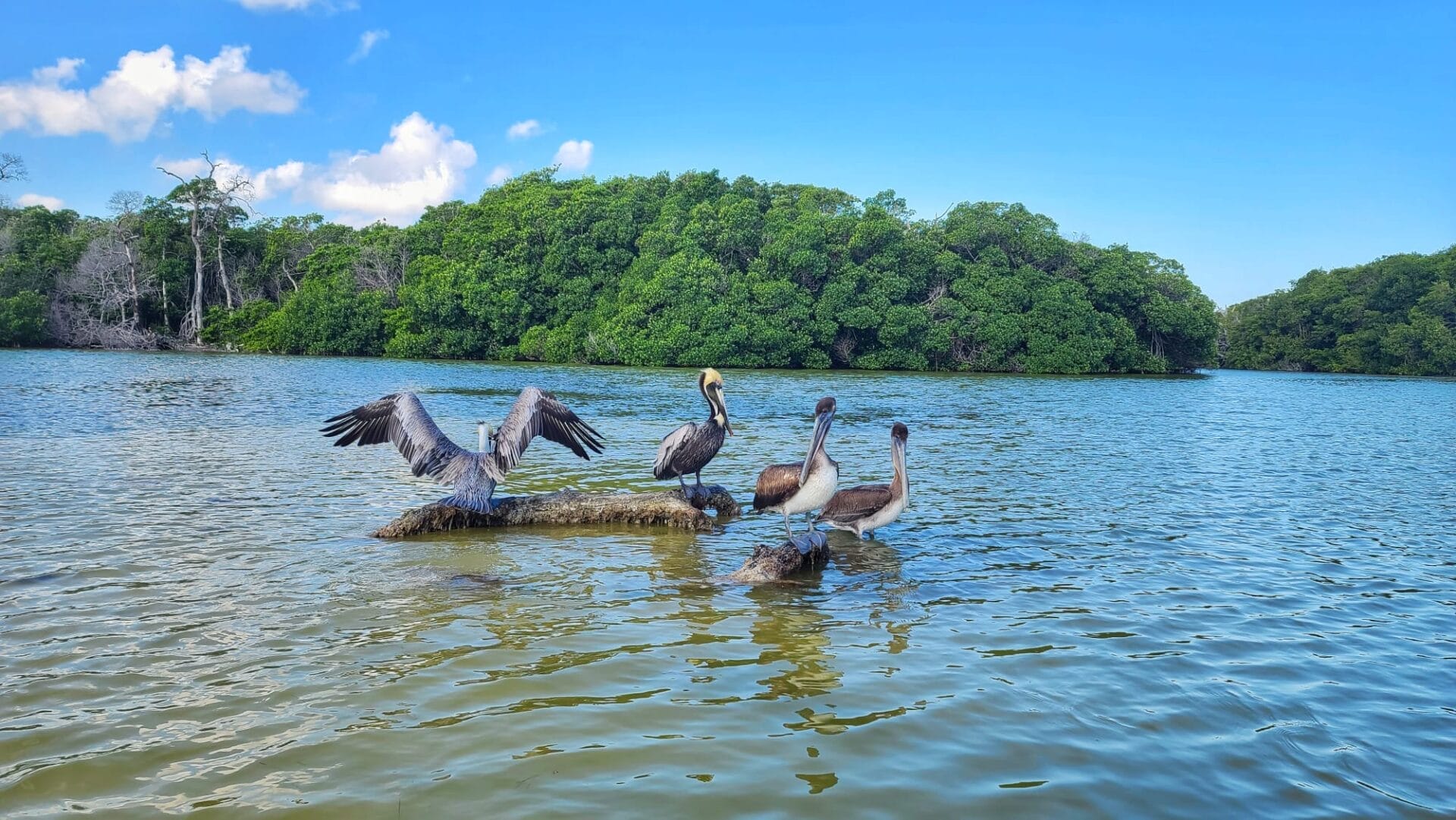
We have been fortunate enough to visit some of the top spots around Cancún where wild animals can be seen in their natural habitat.
During the past year that we have lived in Playa Del Carmen we went on quite a few adventures around the Riviera Maya and beyond with our little one and loved how she experienced all of the nature in this area with wonder and enthusiasm.
So grab your binoculars and get ready for a wild adventure in Cancun and surrounding areas of the Yucatan Peninsula – the animals are waiting!
What Kind Of Wildlife Does Cancun Have?
Cancun is not just about beaches and resorts, it’s also a hotspot for wildlife enthusiasts.
With a variety of species of birds like the toucan and heron, as well as howler monkeys swinging through the trees, there’s no shortage of wild animals to see in Cancun.
The coastal region of Cancun and Riviera Maya is also home to green sea turtles that lay their eggs on the beaches, making it an unforgettable experience to witness.
For those looking for a more ecological experience, taking a trip to the mangrove lagoon in places like Akumal or Celestun can provide an opportunity to see endangered species in their natural habitat.
And let’s not forget the gentle giants of the sea – whale sharks can be spotted swimming in the waters off the coast, offering a once-in-a-lifetime chance to see these beautiful creatures up close.
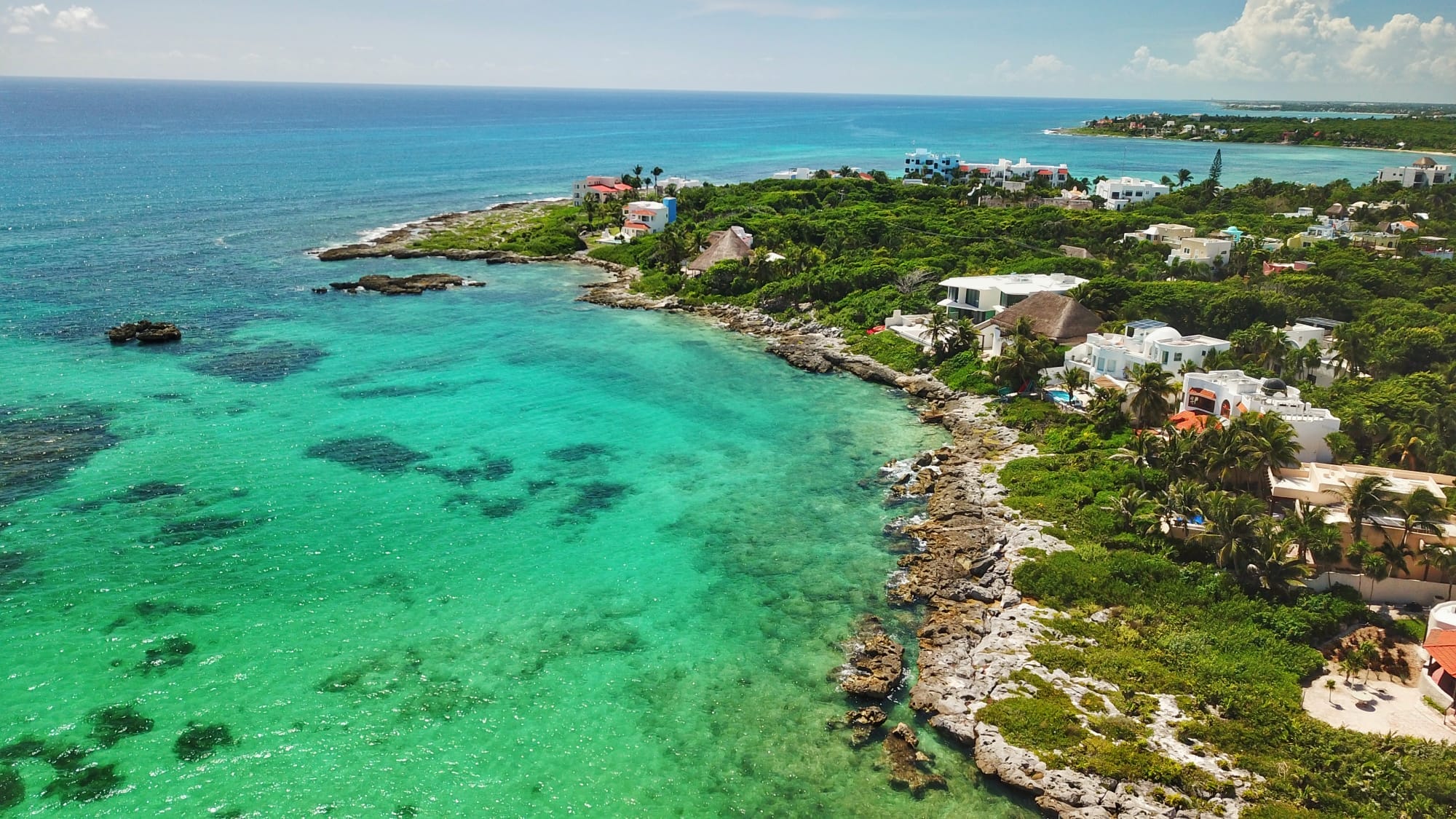
1. The Magnificent Sea Turtles of Cancún
One of the most iconic animals you can encounter while in Cancún is the magnificent sea turtle.
These gentle giants can be spotted swimming gracefully in the crystal-clear waters that line the beaches of Cancún.
It’s an unforgettable experience to witness these majestic creatures in their natural habitat, gliding through the waves with ease.
Sea turtles are an endangered species, and efforts are being made to protect their nesting sites along the coastline.
If you’re lucky, you might even witness a sea turtle coming ashore to lay its eggs, a truly magical sight that showcases the circle of life in the wild.
2. The Lively Dolphins of Cancún
Another enchanting marine species you can see in Cancún is the lively dolphins.
These intelligent creatures are often spotted leaping and playing in the warm waters of the Caribbean Sea – We even spotted some on our visit to Isla Holbox.
Many tour operators offer the opportunity to swim with dolphins, providing a surreal and interactive experience with these friendly animals.
Watching dolphins in their natural habitat is an ecological delight, as you observe them navigate the ocean waves with a sense of freedom and grace.
Their playful nature and acrobatic displays make for a captivating animal encounter that’s sure to leave you in awe.

3. The Majestic Whale Sharks
Cancún is also known for its majestic whale sharks, the gentle giants of the sea.
These magnificent creatures can be found swimming in the waters around the Yucatan Peninsula, offering a thrilling way to see these massive fish up close in their natural environment.
Swimming with whale sharks is a popular eco-tourism activity in Cancún, allowing visitors to snorkel alongside these peaceful creatures and witness their serene presence in the vast Caribbean waters.
It’s a fascinating and humbling experience to share the ocean with these magnificent beings.
4. The Intriguing Iguanas
Among the land-dwelling animals in Cancún, the intriguing iguanas are a common sight.
These reptiles can be found basking in the sun near the lush jungles and mangrove forests that inhabit the region.
With their distinctive appearance and agile movements, iguanas add a touch of exotic charm to the landscape.
Exploring the jungle areas around Cancún might lead you to encounter these fascinating lizards in their natural habitat.
Their presence contributes to the rich biodiversity of the area, showcasing the diverse creatures that calls Cancún home.
You will most certainly catch a few of these cool animal species in Cancún wandering around Mayan Ruins like the ones in Tulum!

5. The Graceful Flamingos
One of the most visually striking animals you may come across in Cancún is the graceful flamingo.
These elegant birds can be spotted wading in the shallow waters of lagoons and coastal areas, their vibrant pink plumage contrasting beautifully with the blue skies and green mangroves.
Watching a flock of flamingos gracefully move through the water is a sight to behold, offering a glimpse into the beauty of nature’s creations.
These magnificent birds add a touch of charm and color to the scenic landscapes of Cancún, creating a picturesque setting for wildlife enthusiasts.
6. The Protective Crocodiles
While exploring the mangrove ecosystems and lagoons around Cancún, you may come across the protective crocodiles that inhabit these coastal waters.
These ancient reptiles are a vital part of the local ecosystem, playing a crucial role in maintaining the balance of nature in the region.
Observing crocodiles in their natural habitat provides an insight into their behavior and adaptation to the surrounding environment.
With their powerful presence and stealthy movements, these creatures showcase the raw and untamed beauty of the Cancun wilderness, adding a sense of adventure to your wildlife encounters.
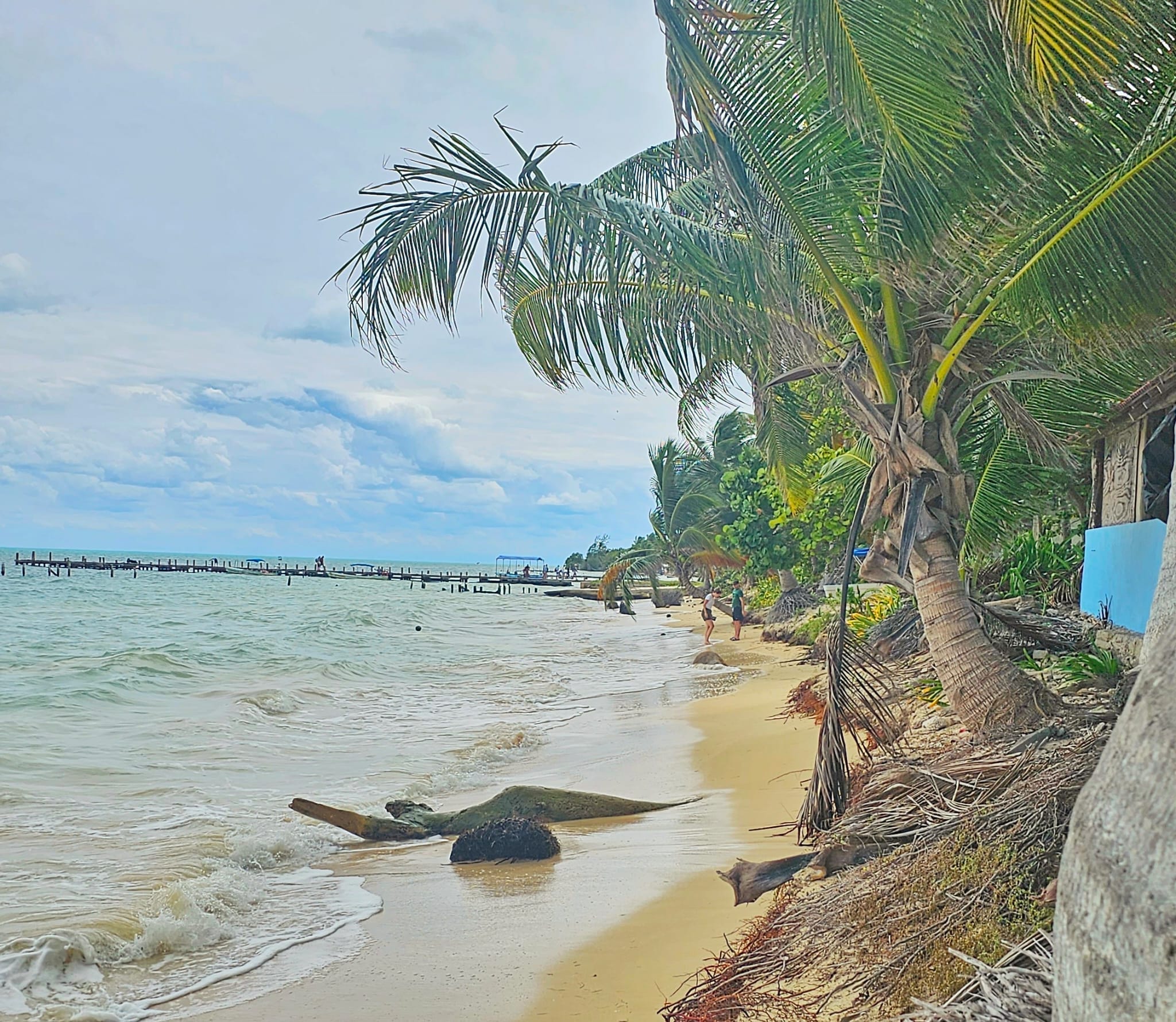
5 Best Animal Sighting Spots In the Mexican Caribbean
1. Rio Lagartos
Venture to Rio Lagartos, a pristine biosphere reserve located on the Yucatan Peninsula, to witness a diverse range of animals in their natural habitats.
Explore the mangrove forests and lagoons of Rio Lagartos to encounter thousands of flamingos, crocodiles, and various bird species that inhabit this biodiverse region.
Embark on a boat tour through the winding waterways of Rio Lagartos for a chance to see wildlife up close and immerse yourself in the sights and sounds of nature.
This ecological paradise offers an unforgettable opportunity to connect with the diverse fauna of the Mexican Caribbean in a serene and untouched setting.
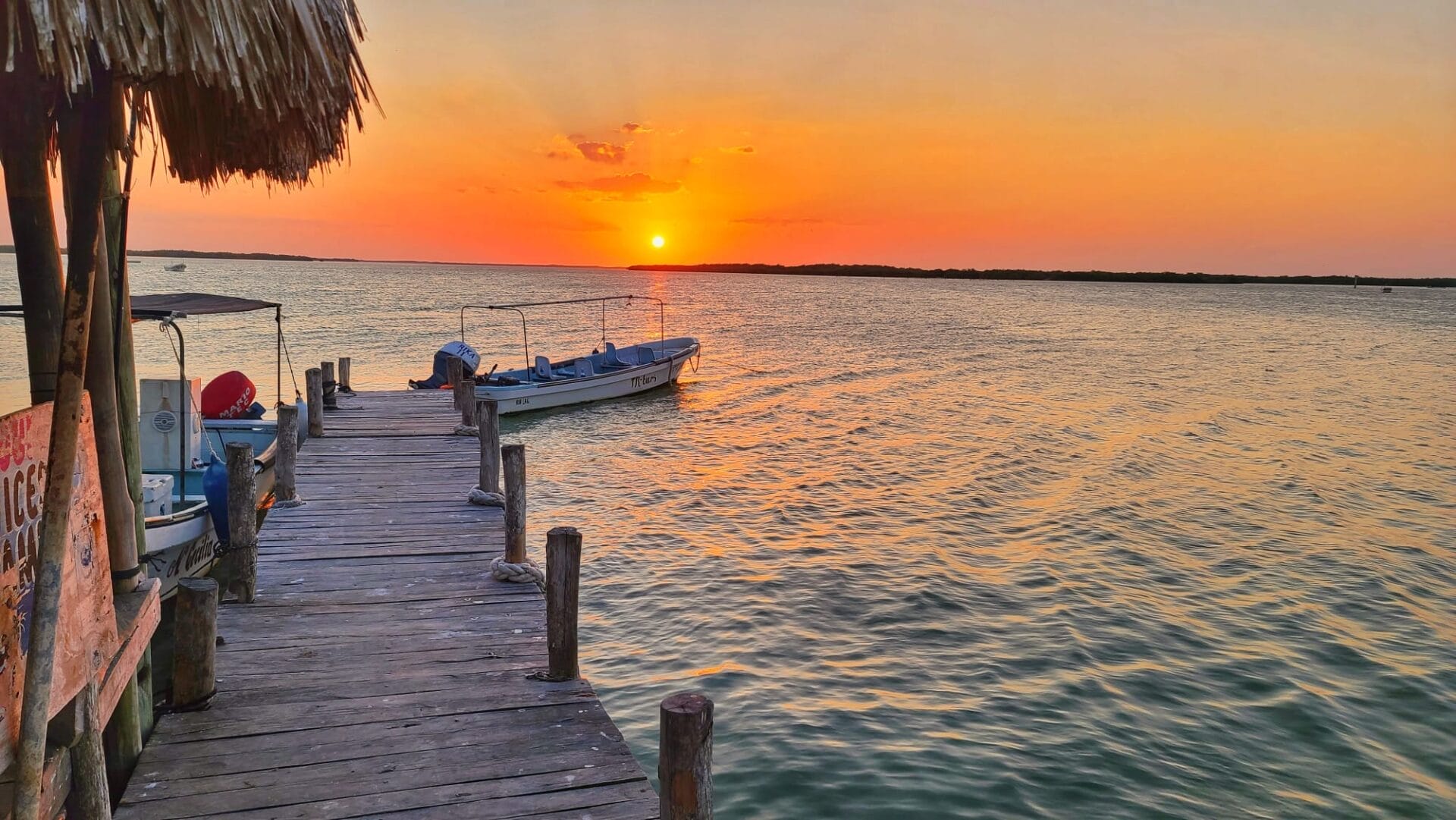
Some Interesting Facts About Rio Lagartos:
- Rio Lagartos is a small fishing village located on the northern coast of the Yucatán Peninsula in Mexico.
- The name Rio Lagartos translates to “Alligator River” in English, but despite its name, there are no alligators in the area. The name actually comes from the large number of American crocodiles that inhabit the surrounding lagoons and estuaries.
- The town is part of the Rio Lagartos Reserve, which is a protected area known for its diverse bird and wildlife species. It is home to hundreds of bird species, including flamingos, herons, and egrets.
- The reserve also contains the largest nesting site for flamingos in Mexico, with thousands of these pink birds making their homes in the shallow waters of the lagoons.
- Rio Lagartos is a popular destination for eco-tourism, offering visitors the chance to explore the mangrove swamps, salt flats, and wetlands teeming with wildlife.
- The town is also known for its salt production, which has been a major industry in the area for centuries. Visitors can tour the salt flats and learn about the traditional methods of salt harvesting.
- The nearby Las Coloradas salt flats are famous for their vibrant pink waters, which are caused by the high concentration of salt and algae in the water.
- In addition to its natural beauty, Rio Lagartos is also known for its delicious seafood dishes, particularly the locally caught fish and shrimp. Visitors can enjoy fresh seafood at the many restaurants in town.
- The town is a popular stop for birdwatchers and nature enthusiasts, with several eco-tours and boat trips available to explore the surrounding area.
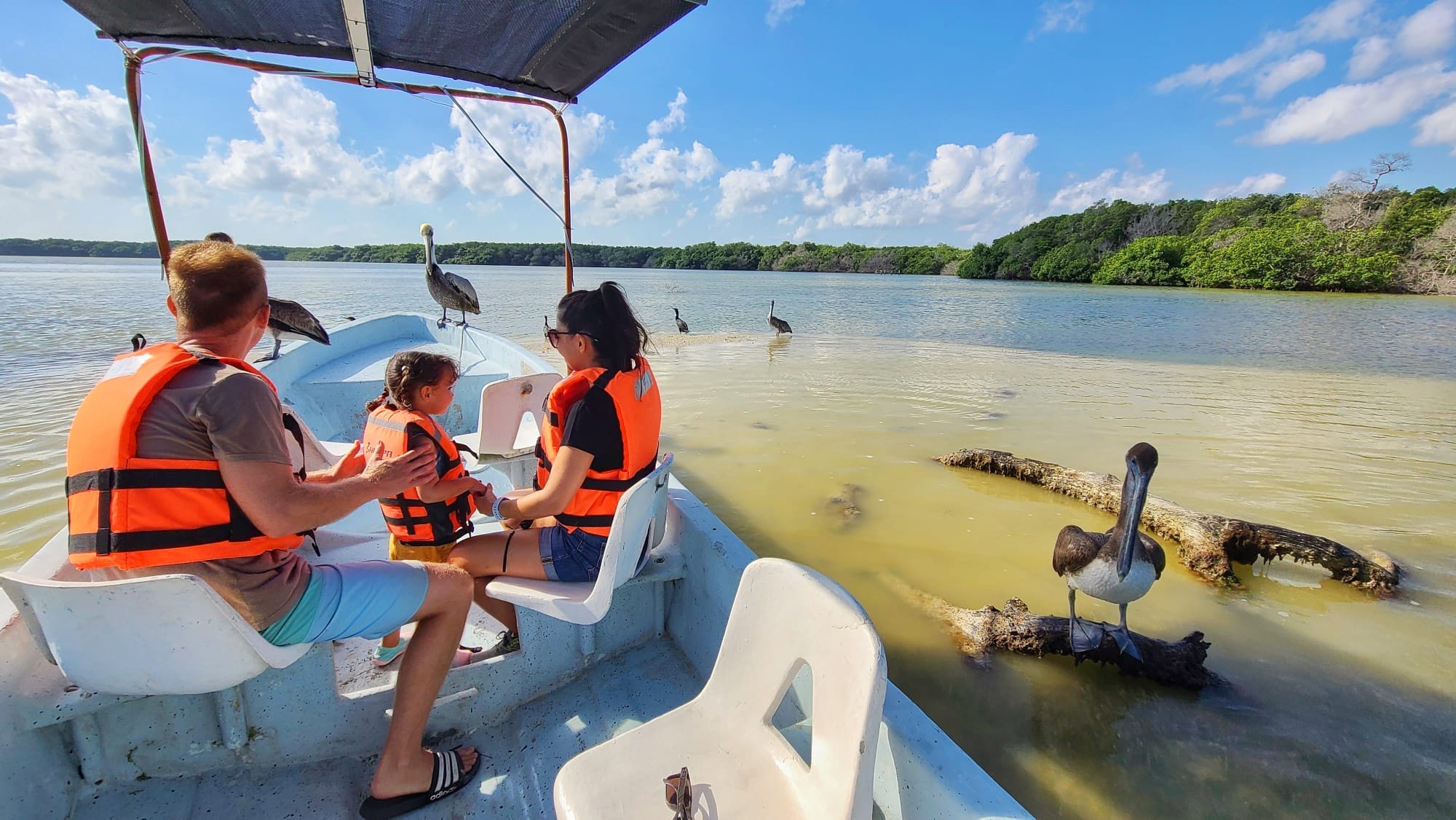
How To Visit Rio Lagartos:
- Plan your visit: Before you visit, make sure to plan your trip and book accommodations in advance.
- Get there: The nearest airport to Rio Lagartos is the Cancun International Airport, which is about a 3-hour drive away. You can rent a car and drive to Rio Lagartos, or you can take a bus or hire a taxi.
- Take a boat tour: One of the best ways to experience Rio Lagartos is by taking a boat tour through the estuary. These tours are led by local guides who can point out animals, explain the ecosystem, and take you to see the famous pink flamingos that live in the area.
- Explore the town: While in Rio Lagartos, take some time to explore the town itself. Visit the local market, try some traditional Yucatecan cuisine, and chat with the friendly locals.
- Visit nearby attractions: Rio Lagartos is located near several other attractions that are worth a visit, including the Mayan ruins of Ek Balam and the Las Coloradas pink salt lakes. Consider adding these sights to your itinerary for a well-rounded trip.
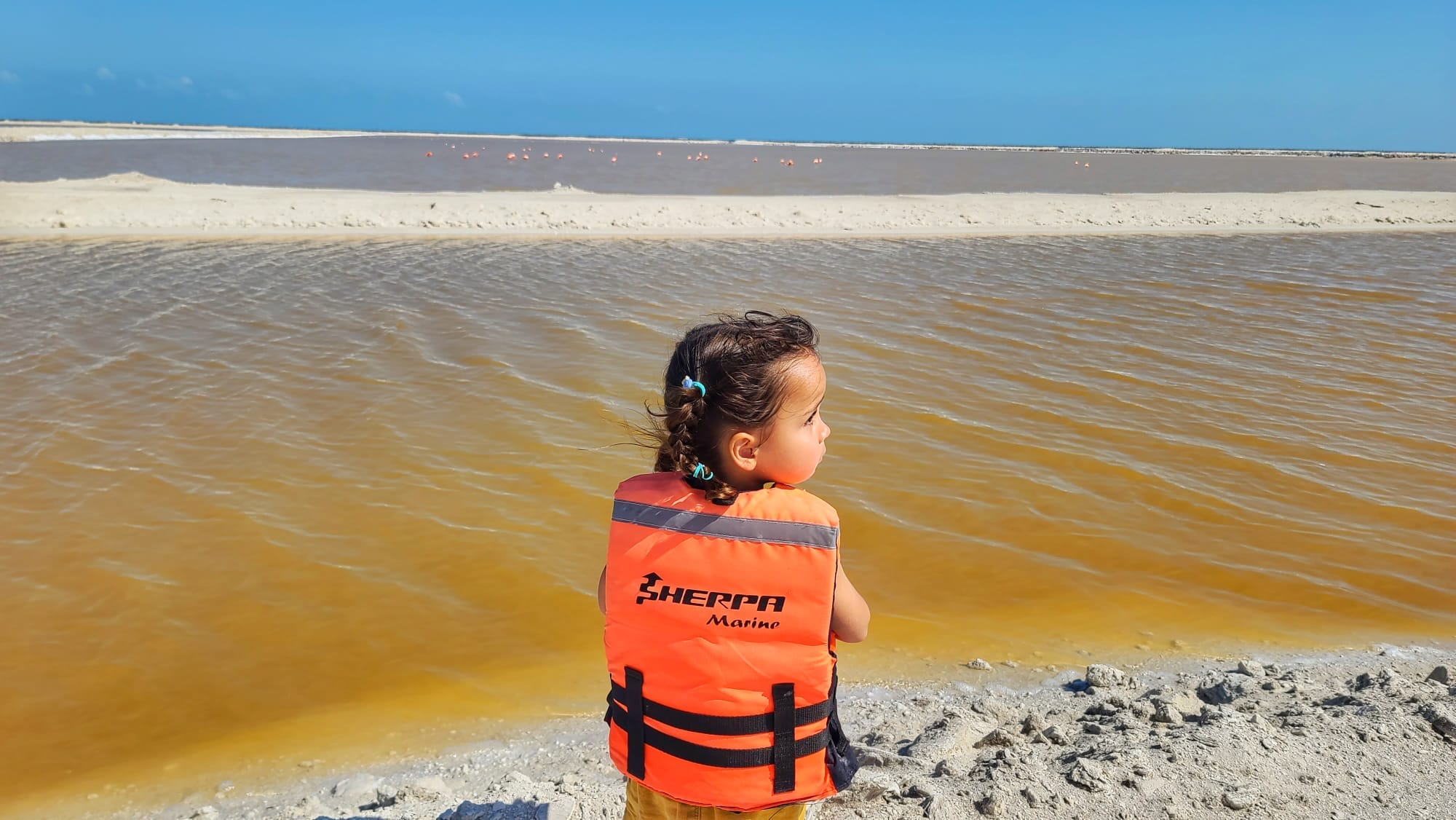
What Animals You May See In Rio Lagartos:
- American Flamingos
- Crocodiles
- White and Brown Pelicans
- Ospreys
- Herons
- Egrets
- Various species of shorebirds
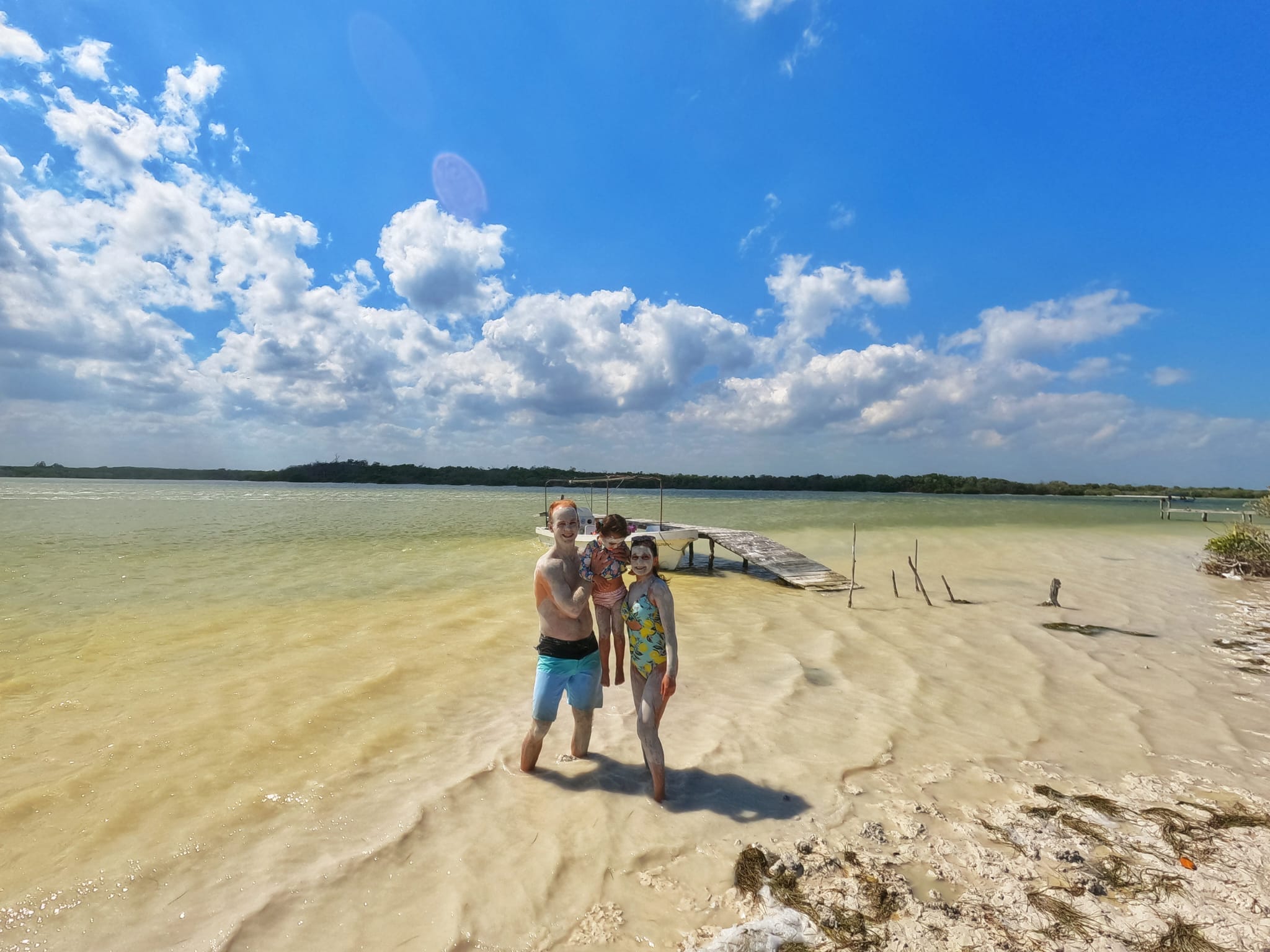
Places To Visit Near Rio Lagartos:
- Ek Balam Archaeological Site: Located about 40 minutes away from Rio Lagartos, Ek Balam is a lesser-known Maya archaeological site with impressive ruins that are worth visiting.
- Las Coloradas: Known for its pink salt flats, Las Coloradas is a unique and beautiful natural phenomenon located about 30 minutes away from Rio Lagartos.
- Isla Holbox: A popular island destination that offers stunning beaches, crystal-clear waters, and a laid-back atmosphere. It can be reached by ferry from nearby Chiquila.
- Cenote Hubiku: A beautiful cenote located about 45 minutes away from Rio Lagartos, with crystal-clear waters perfect for swimming and snorkeling.
- Valladolid: A picturesque colonial town with colorful buildings, charming streets, and a relaxed atmosphere. It is about an hour and a half away from Rio Lagartos by car.

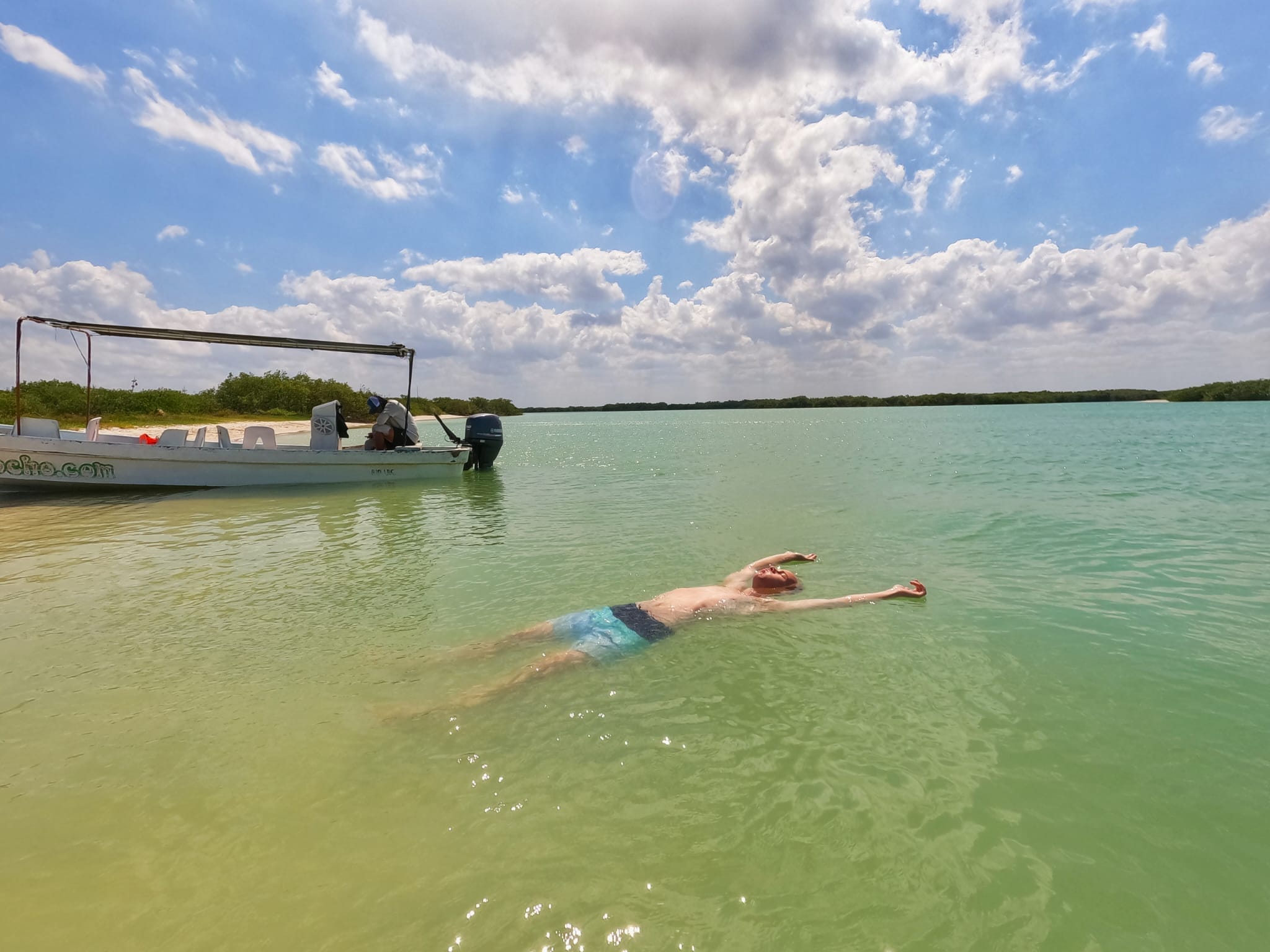
We stayed in the town of Rio Lagartos and enjoyed the quiet and peaceful atmosphere. The restaurants were fantastic and we loved the walks we went on along the water in the evenings.
Since we were in the area, we also went on a day trip to El Cuyo before heading back to Playa Del Carmen.
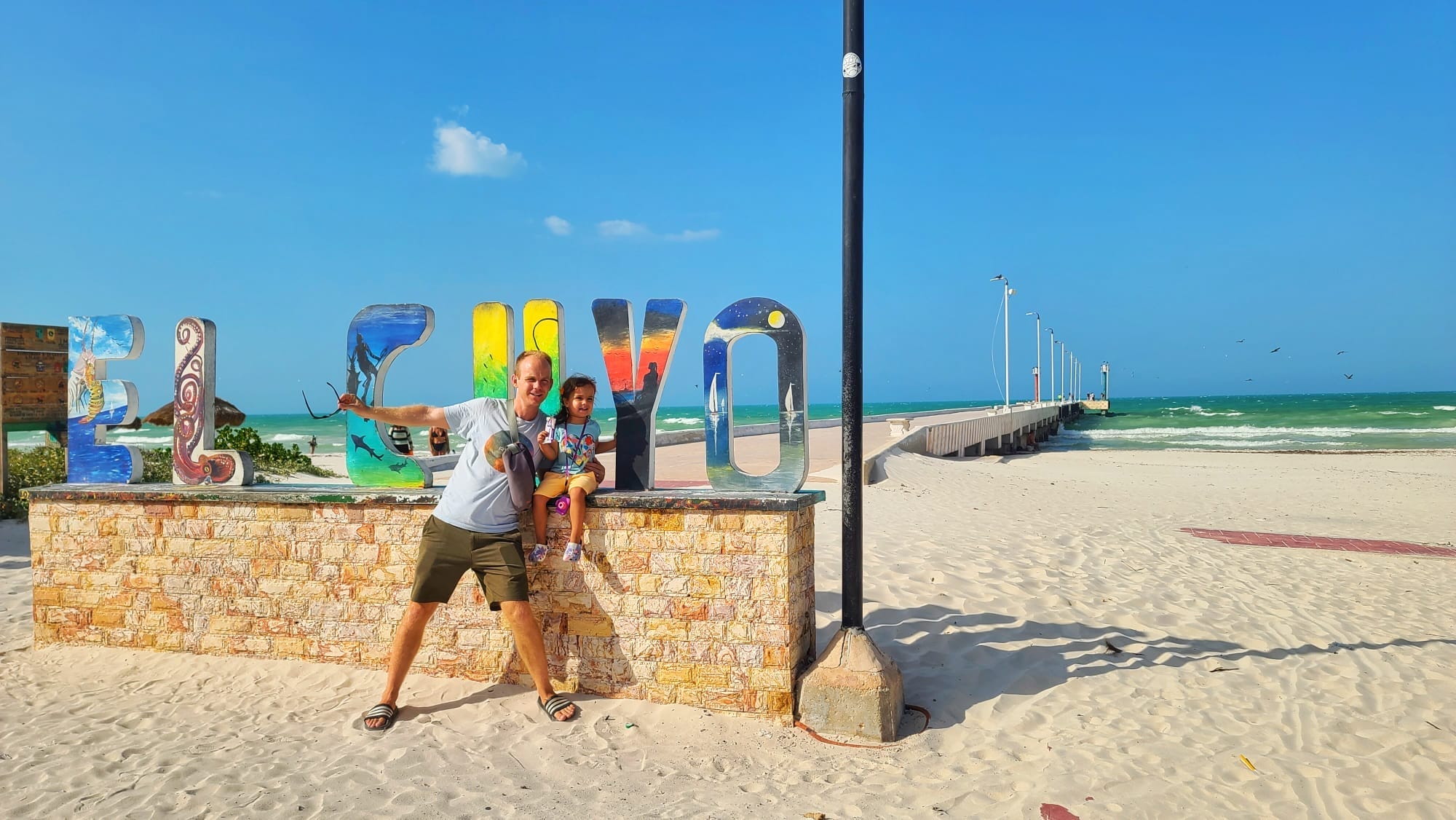
2. Celestún
Visit Celestún, a coastal town known for its stunning beaches and thriving ecosystem that supports a variety of wildlife species.
Take a tour of the Celestún Biosphere Reserve to explore the mangrove swamps and lagoons that are home to flamingos, manatees, and diverse bird species.
Experience the natural beauty of Celestún as you observe wildlife in their native habitats, from gentle manatees gliding through the waters to vibrant bird species nesting in the mangroves.
Celestún offers a peaceful retreat into nature, providing a glimpse into the rich biodiversity of the Mexican Caribbean.
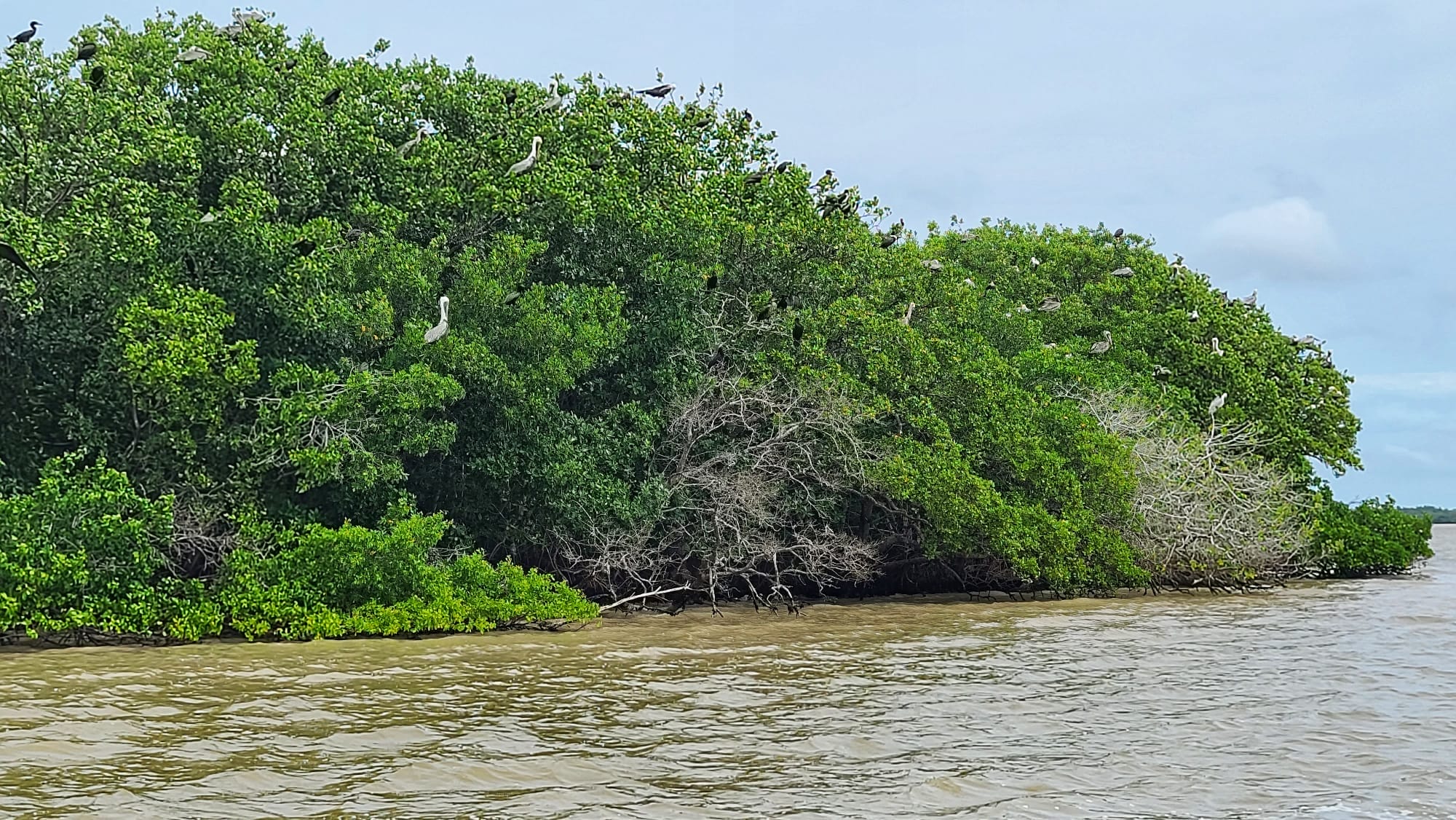
Some Interesting Facts About Celestún:
- Celestun Reserve is a protected area located in the state of Yucatan, Mexico. It covers an area of approximately 146,000 hectares.
- The reserve is home to a diverse range of flora and fauna, including over 300 species of birds, such as flamingos, herons, and pelicans.
- One of the main attractions of the reserve is the large population of American flamingos that nest in the area. Celestun is one of the most important nesting sites for flamingos in the region.
- The reserve also contains mangrove forests, salt marshes, and a network of freshwater springs known as “ojos de agua.”
- Celestun Biosphere Reserve was designated a UNESCO World Heritage Site in 2000, in recognition of its importance as a wetland habitat for migratory birds.
- Visitors to the reserve can take guided boat tours through the mangroves to see the flamingos up close, as well as other animals such as crocodiles, sea turtles, and dolphins.
- The local community in Celestun relies on ecotourism as a source of income, and sustainable tourism practices are promoted within the reserve.
- The Reserve is also a designated Ramsar site, which means it is recognized as a wetland of international importance for the conservation of biodiversity and sustainable use of natural resources.
- Celestun is located about 90 kilometers west of the city of Merida, making it a popular day trip destination for visitors to the Yucatan Peninsula.
- The best time to visit Celestun Biosphere Reserve is during the winter months when the flamingos are most active and abundant.
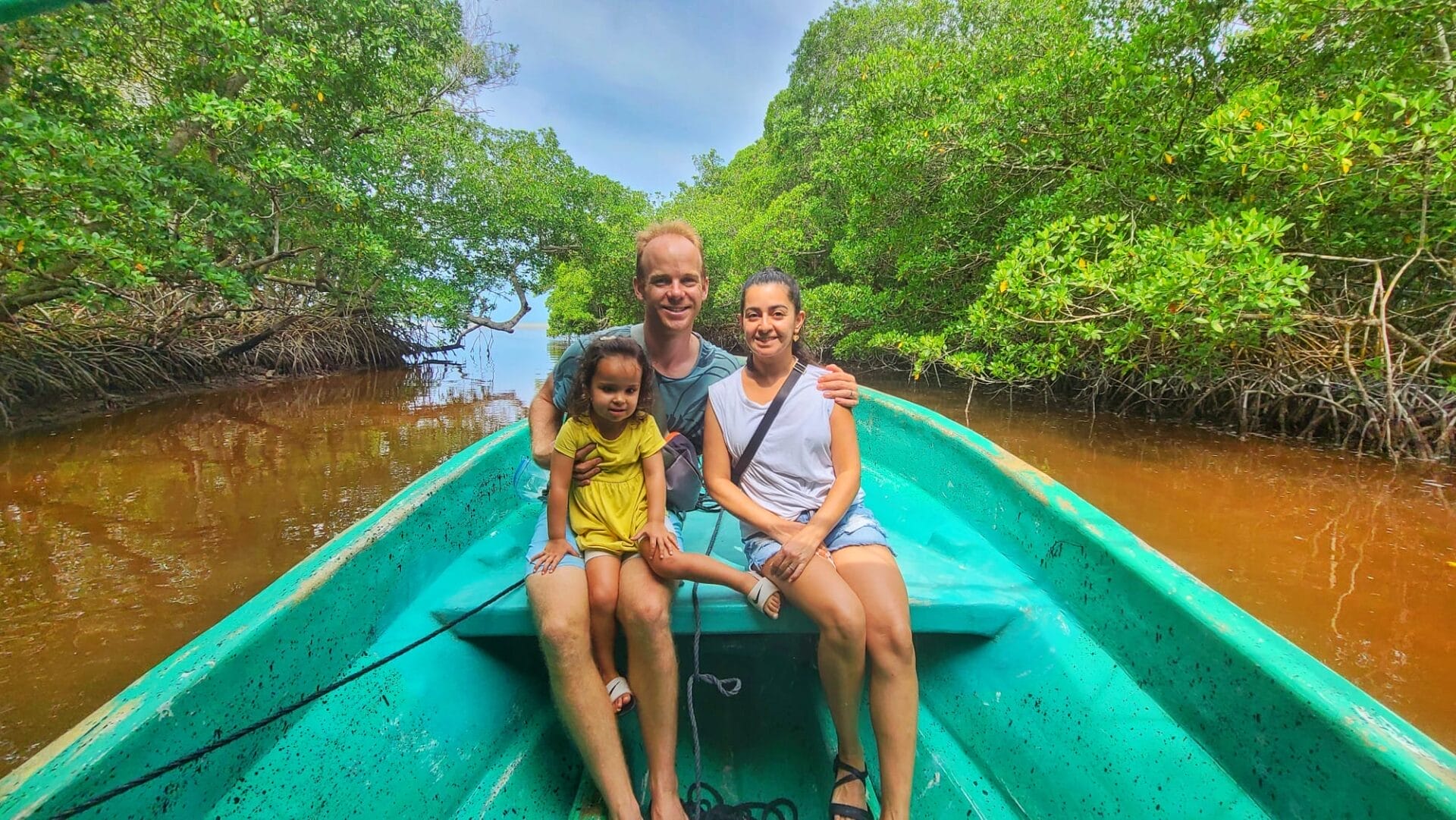
How To Visit Celestún:
- Getting to Celestún: Celestún is located about 91 kilometers west of Mérida, the capital city of Yucatán. The most common way to reach Celestún is by driving, which takes about 1.5 to 2 hours from Mérida. Alternatively, you can also take a bus from Mérida to Celestún, with several daily departures.
- Visiting the Celestún Biosphere Reserve: Celestún is best known for its stunning natural beauty, including the Celestún Biosphere Reserve. This reserve is home to a diverse range of flora and fauna, including flamingos, herons, and other bird species. Visitors can explore the reserve by taking a boat tour through the mangroves or by walking along the designated nature trails.
- Relaxing on the Beach: Celestún also boasts beautiful beaches with calm, turquoise waters ideal for swimming and sunbathing. Playa Celestún and Playa San Bruno are popular beaches in the area where you can relax and enjoy the peaceful surroundings.
- Trying the Local Cuisine: While in Celestún, be sure to sample some of the local Yucatecan cuisine. Try traditional dishes such as panuchos, salbutes, and cochinita pibil, which are all popular in the region. You can also enjoy fresh seafood at the local restaurants along the beach.
- Visiting the Mangroves: Another popular activity in Celestún is exploring the mangroves, either on a boat tour or by kayak. The mangroves are home to a variety of animals, including crocodiles, iguanas, and various bird species. Be sure to keep your eyes peeled for these creatures during your visit.
- Staying Overnight: If you want to fully experience the beauty of Celestún, consider staying overnight in one of the local hotels or eco-lodges. This will allow you to take in the tranquil atmosphere of the town and enjoy the stunning sunsets over the Gulf of Mexico.
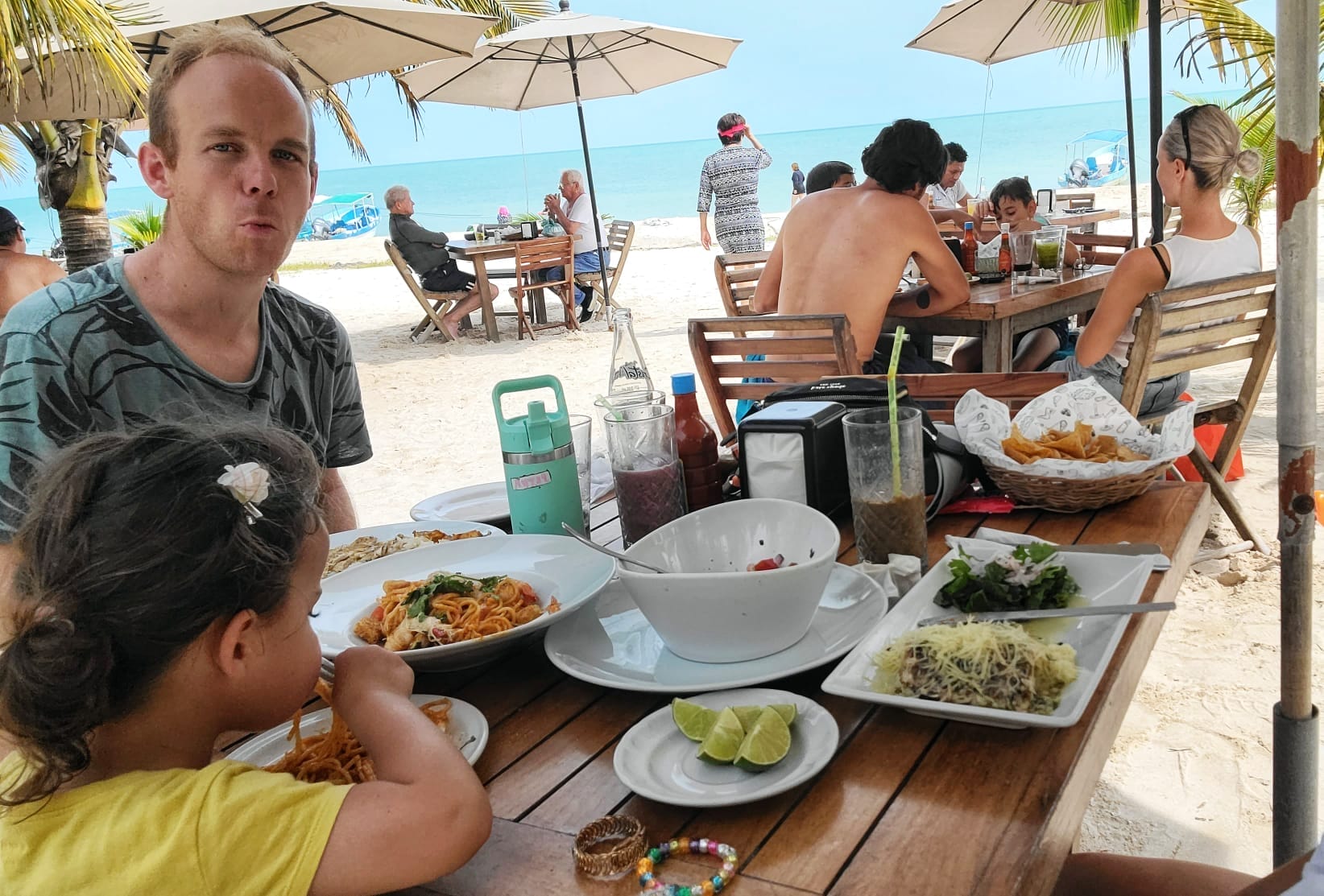
We visited Celestún as day trip from Merida where we were staying for a few days and it was very convenient.
While you can easily book a boat tour in advance, we decided to try getting one in town.
As soon as we parked our car in the town center we had a couple of tour people approach us with offers.
They were easy to negotiate with and we felt the price was fair so we hired the first one. It turned out to be great and we had a wonderful time and learned so much from our guide!
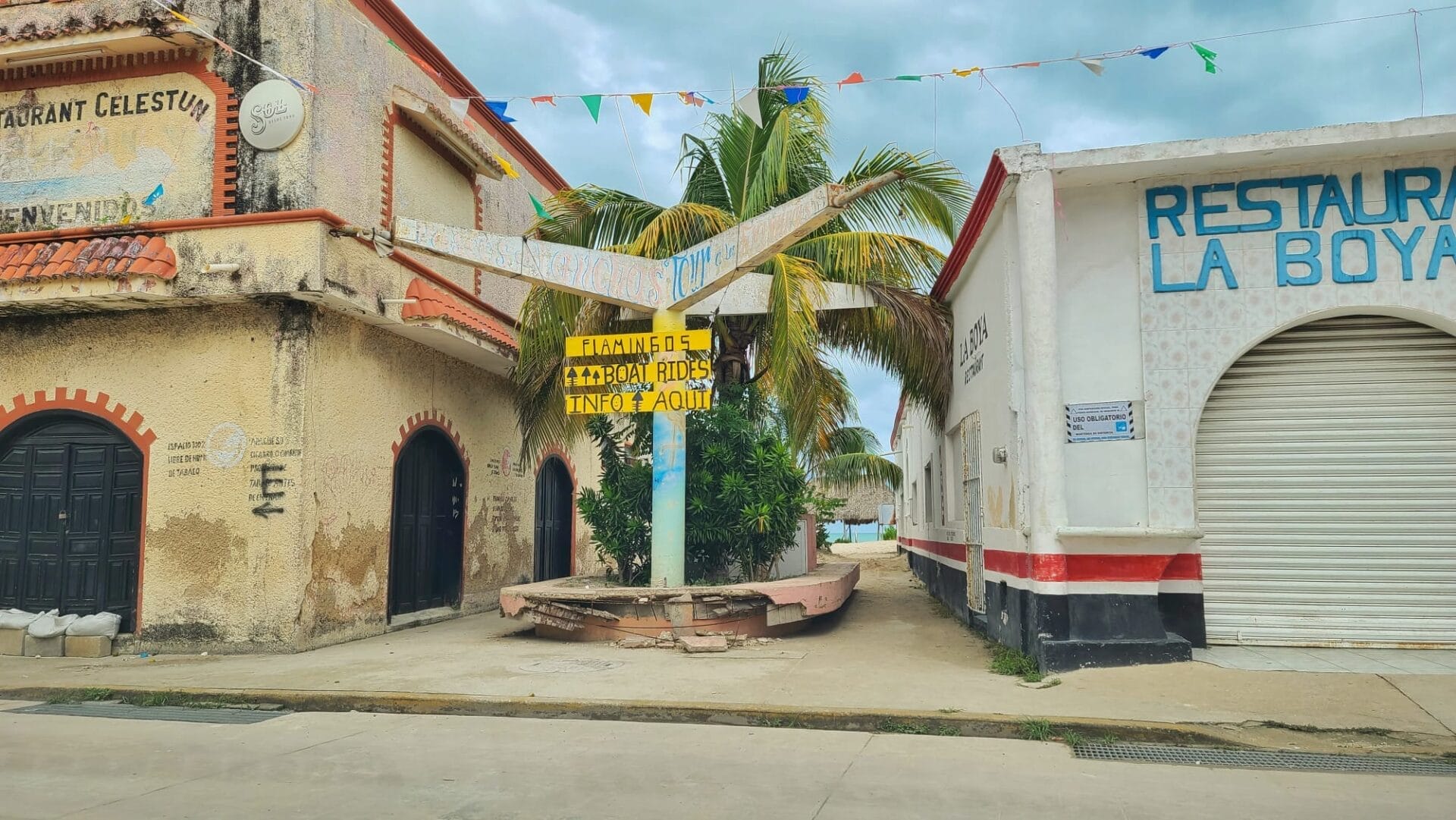
What Animals You May See In Celestún:
- Pink flamingos: Celestún is known for its large population of Mexican pink flamingos, which can be seen feeding and nesting in the nearby wetlands and lagoons.
- American crocodiles: This area is also home to a population of American crocodiles, which can often be spotted basking in the sun along the shoreline.
- Sea turtles: Celestún is a nesting ground for several species of sea turtles, including loggerheads and hawksbills. Visitors may be lucky enough to see them coming ashore to lay their eggs.
- Dolphins: Bottlenose dolphins are commonly seen in the waters around Celestún, particularly on boat tours or while kayaking in the area.
- Birds: Celestún is a birdwatcher’s paradise, with over 300 species of birds recorded in the area. In addition to flamingos, visitors may see herons, egrets, pelicans, and more.
- Mangrove crabs: These colorful crabs can be seen scurrying along the mangrove roots in the wetlands, feeding on algae and detritus.
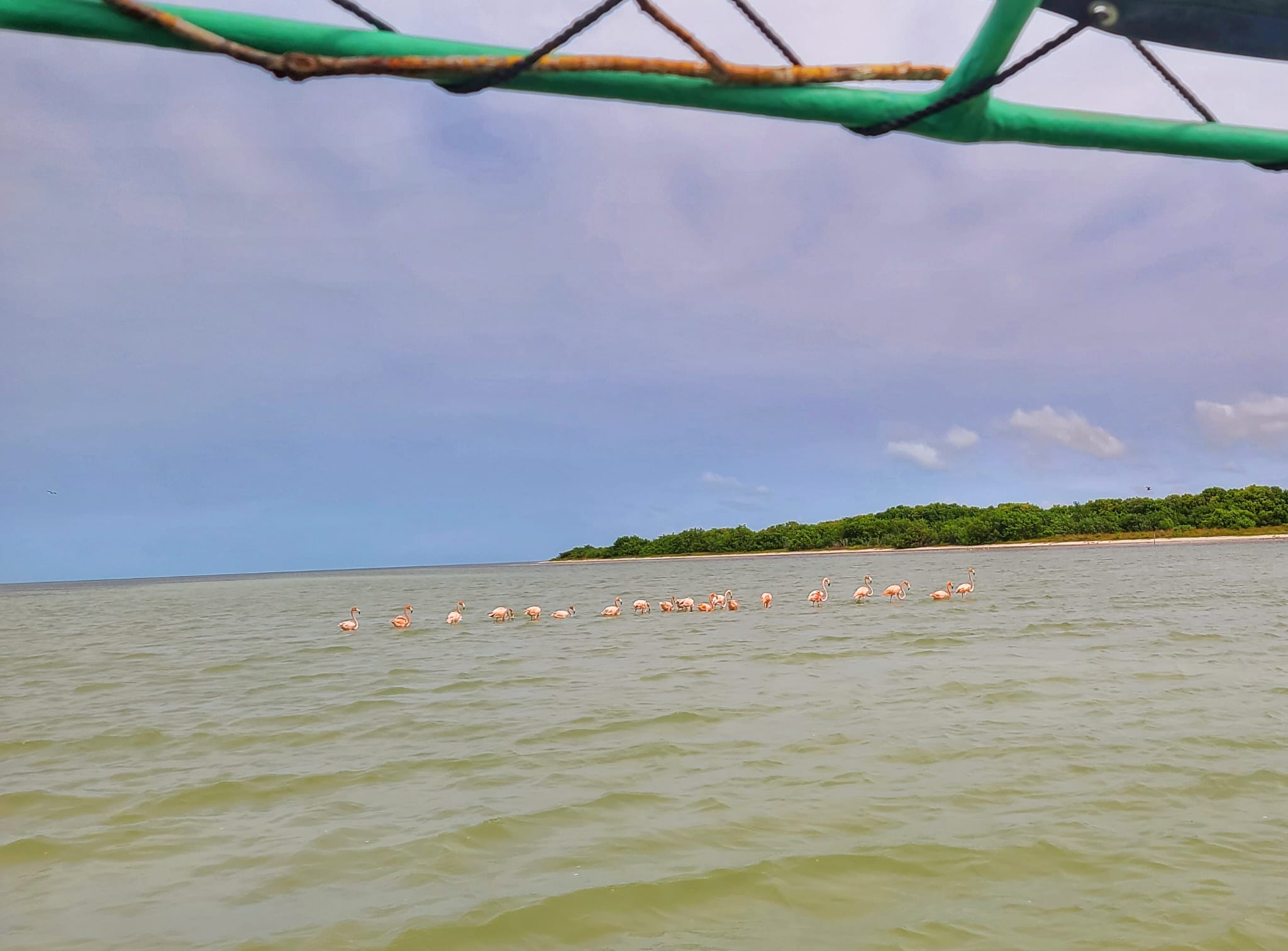
Places To Visit Near Celestún:
- Xcambo Ruins: These ancient Mayan ruins are located near Celestun and offer an opportunity to explore archaeological sites and learn about the region’s ancient history.
- Cenotes: There are several cenotes (natural sinkholes filled with crystal-clear water) in the area surrounding Celestun, perfect for swimming and snorkeling.
- Las Coloradas: This nearby town is known for its vibrant pink salt flats, which are a popular tourist attraction. Visitors can take guided tours to learn about the salt production process and see the stunning pink hues of the water.
- Sisal: This historic port town is located near Celestun and is known for its beautiful beaches and colonial architecture. Visitors can explore the town’s streets, visit the local market, and relax on the sandy shores.
3. Sian Ka’an
Discover Sian Ka’an Biosphere Reserve, a UNESCO World Heritage Site that encompasses a vast stretch of coastal and jungle landscapes teeming with wildlife.
Take a guided tour through Sian Ka’an to spot jaguars, howler monkeys, and a myriad of bird species that inhabit this ecological haven.
Explore the lush mangrove forests and pristine beaches of Sian Ka’an for a chance to witness the incredible diversity of flora and fauna that call this biosphere reserve home.
Immerse yourself in the natural wonders of Sian Ka’an for an eco-adventure that’s both educational and awe-inspiring.
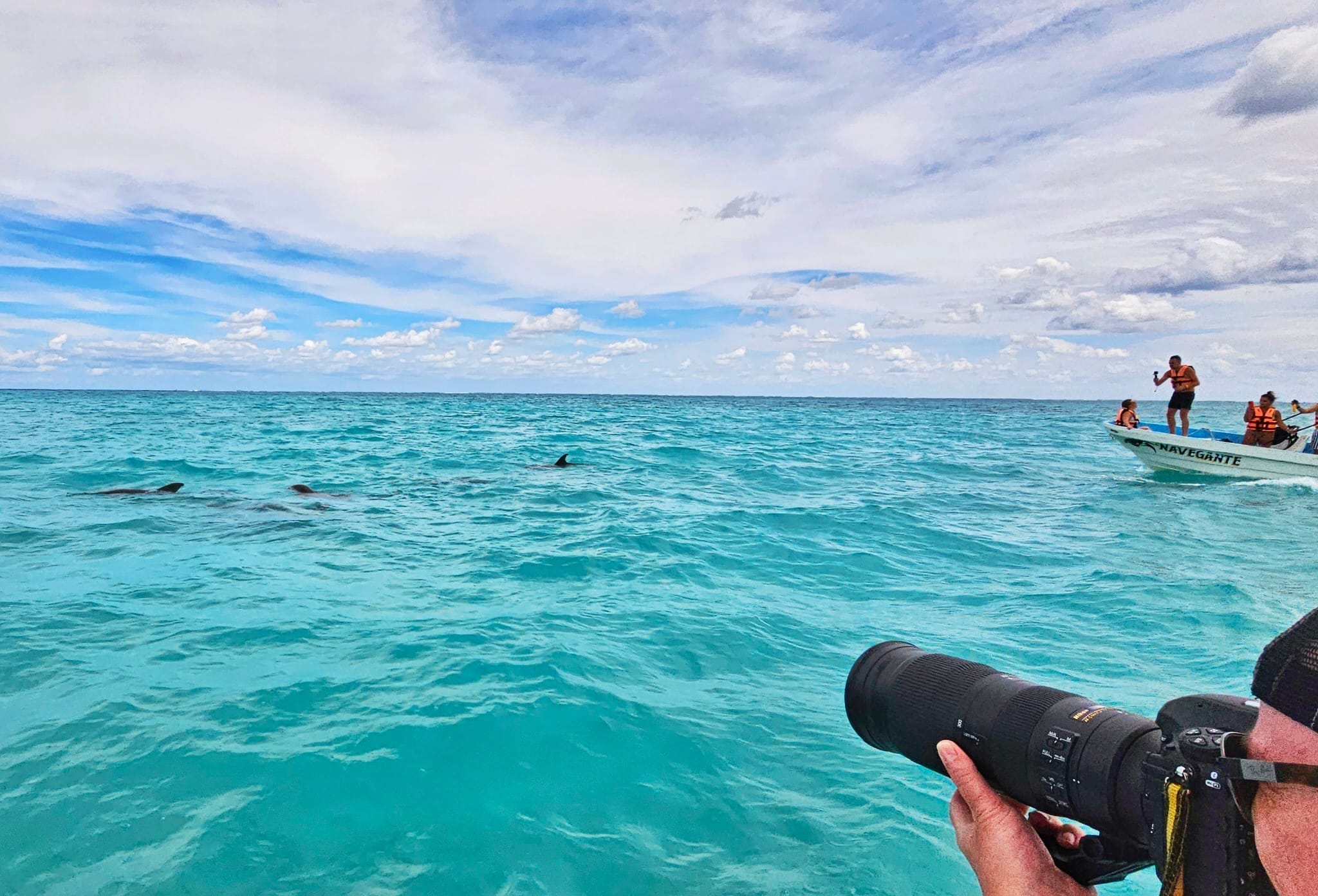
Some Interesting Facts About Sian Kaan:
- Sian Ka’an Biosphere Reserve is a UNESCO World Heritage Site located on the eastern coast of Mexico’s Yucatan Peninsula.
- The reserve covers an area of approximately 1.3 million acres and is home to a diverse range of ecosystems, including tropical forests, wetlands, mangroves, and coral reefs.
- Sian Ka’an is home to over 300 species of birds, as well as numerous species of mammals, reptiles, and marine life, making it a popular destination for birdwatching and wildlife viewing.
- The reserve is also home to several ancient Mayan archaeological sites, including the ruins of Muyil, which can be explored by visitors.
- Sian Ka’an is a popular destination for eco-tourism and sustainable travel, with numerous eco-friendly lodges and tour operators offering experiences such as kayaking, snorkeling, and guided nature walks.
- The name Sian Ka’an means “Origin of the Sky” in the Mayan language, reflecting the reserve’s importance as a sacred place for the ancient Maya people.
- Sian Ka’an Biosphere Reserve is known for its important conservation efforts, including protecting endangered species such as the West Indian manatee and the jaguar.
- In addition to its natural beauty and biodiversity, Sian Ka’an is also an important source of livelihood for local communities, who rely on the reserve’s resources for fishing, agriculture, and tourism.
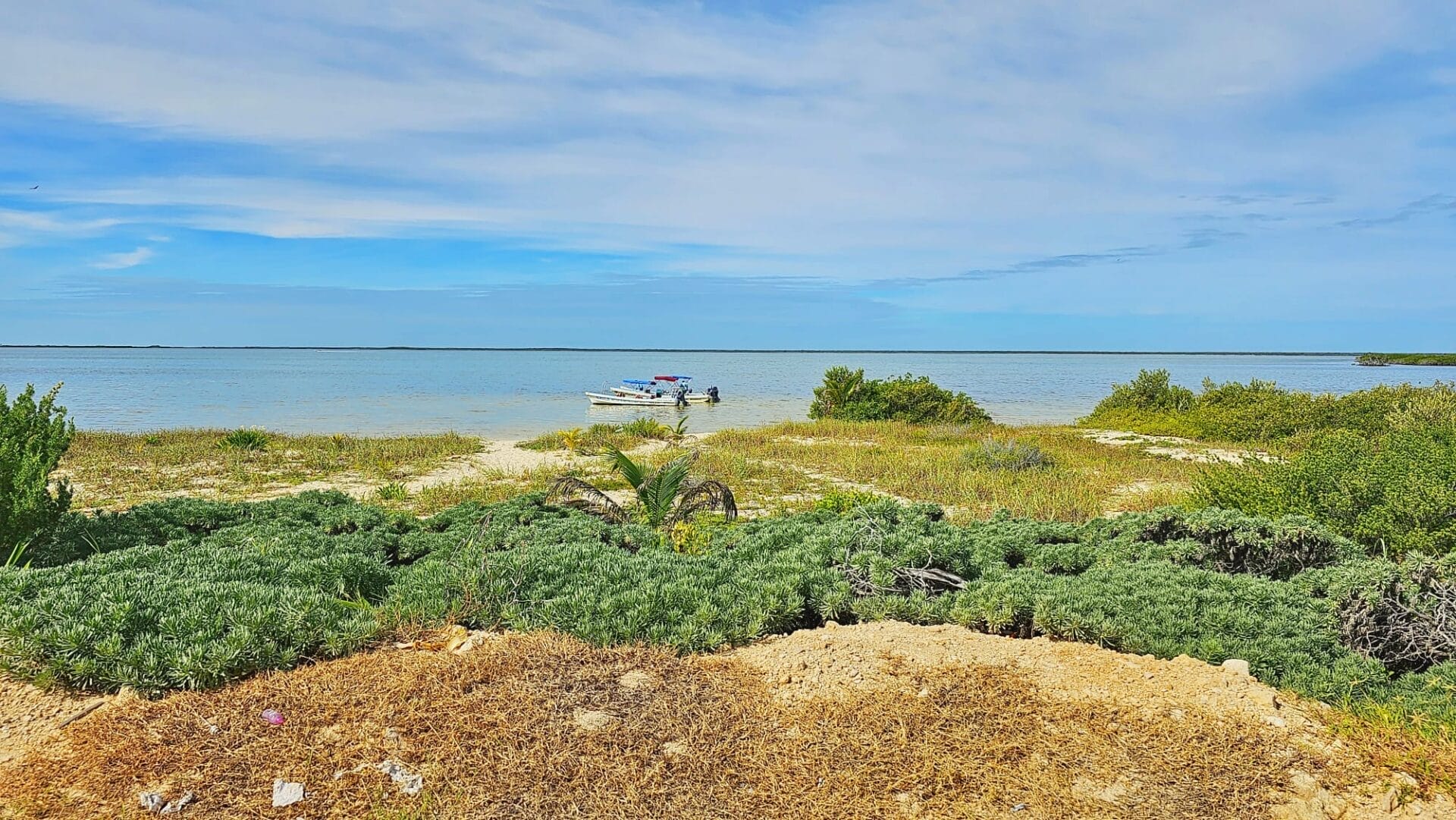
How To Visit Sian Ka’an:
- Research and plan your visit: Before heading to Sian Ka’an Biosphere Reserve, it’s important to do some research on the area and plan your visit accordingly. Consider what activities you would like to do, how long you plan to stay, and what accommodations or tours you may need.
- Decide on transportation: The reserve is located in the Riviera Maya area of Mexico, near Tulum. You can reach Sian Ka’an by car, taxi, or organized tour. If you choose to drive yourself, be aware that some areas of the reserve may require a high-clearance vehicle or 4×4.
- Book a tour or guide: To make the most of your visit to Sian Ka’an, consider booking a tour or hiring a guide. There are various tours available that can take you through the different ecosystems of the reserve, including the mangroves, wetlands, and ruins of ancient Mayan civilizations.
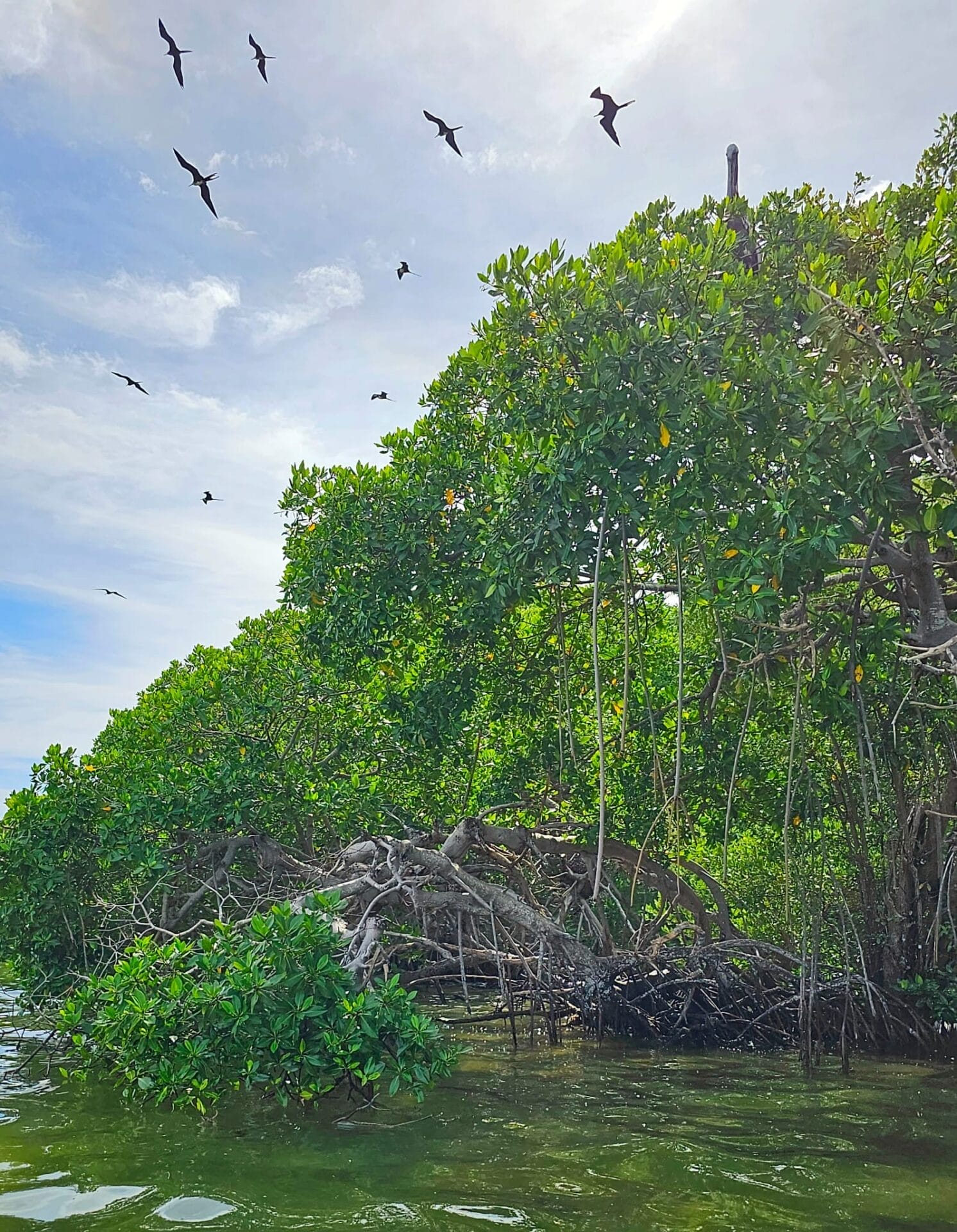
What Animals You May See In Sian Ka’an:
- Jaguars
- Ocelots
- Spider monkeys
- Howler monkeys
- Crocodiles
- Manatees
- Dolphins
- Sea turtles
- A wide variety of bird species such as toucans, parrots, and flamingos.
This is our favorite place to see dolphins and, in our opinion, one of the best places to see them near Cancún!
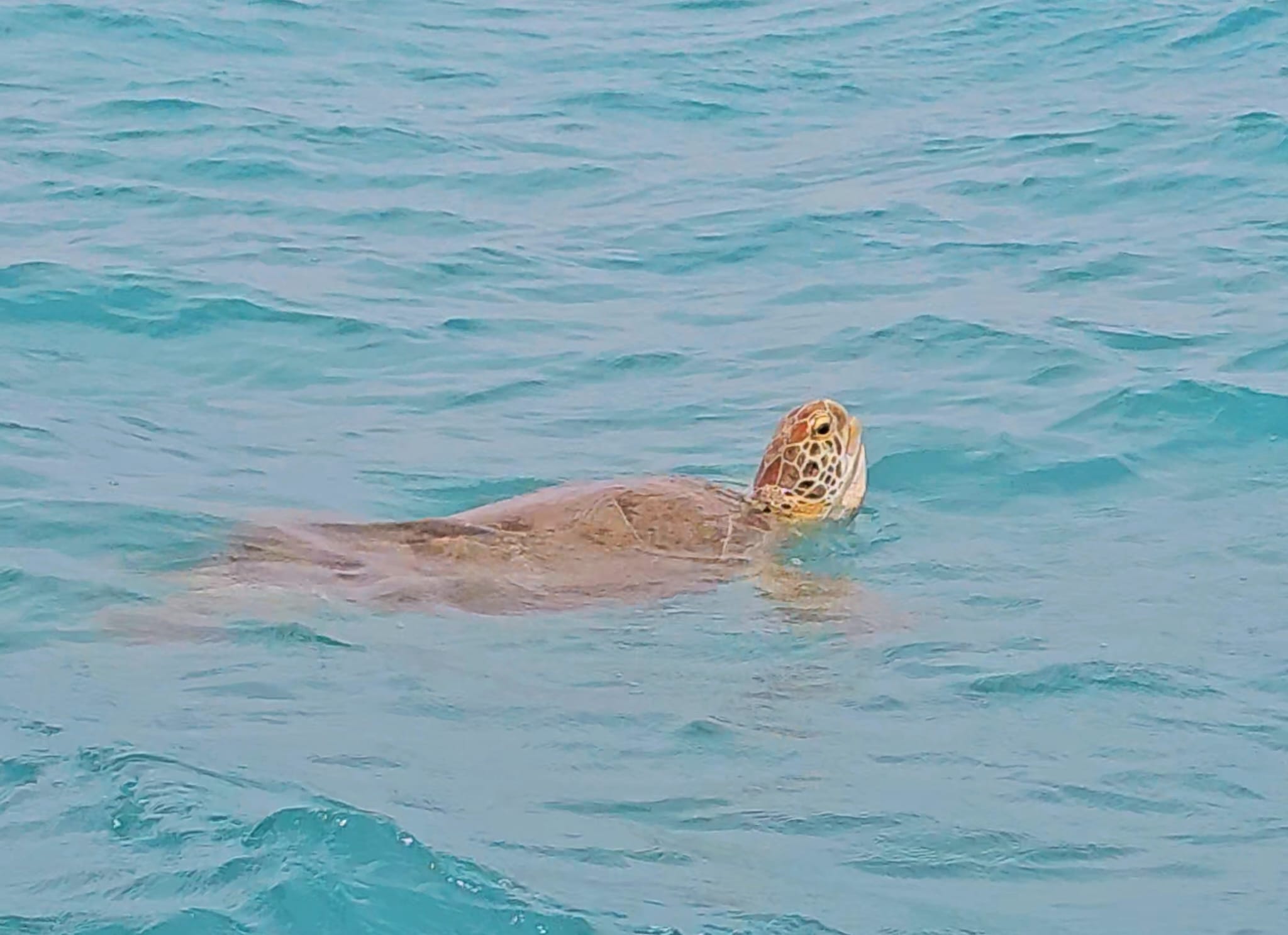
Places To Visit Near Sian Ka’an:
- Tulum ruins: an ancient Mayan archaeological site located on a cliff overlooking the Caribbean Sea
- Cenotes: natural sinkholes filled with crystal-clear freshwater, perfect for swimming and snorkeling
- Playa del Carmen: a lively beach town with plenty to do including shopping, dining, and nightlife options
- Akumal: a beautiful beach known for its sea turtle population and great snorkeling opportunities
- Xel-Ha Park: an ecological waterpark with snorkeling, zip-lining, and other water activities
- Cobá ruins: another ancient Mayan archaeological site with the tallest pyramid in the Yucatan Peninsula
- Cozumel: one of the best islands to visit near Cancun and known for its diving and snorkeling sites
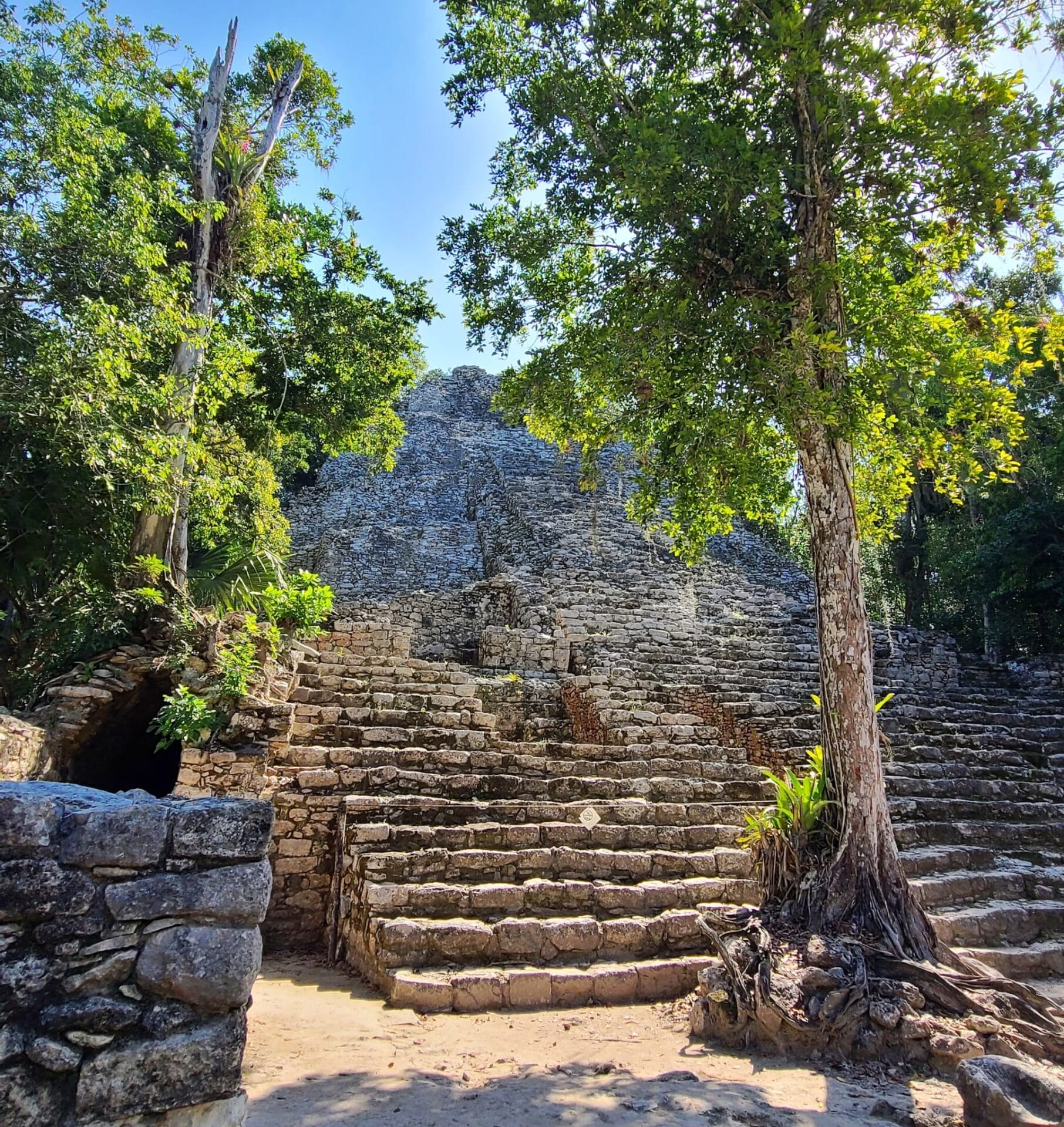
4. Isla Contoy
Embark on a journey to Isla Contoy, a secluded island paradise off the coast of Cancun that serves as a sanctuary for numerous seabirds and marine species.
Join a guided tour to Isla Contoy to observe nesting birds, green sea turtles, and vibrant coral reefs that thrive in the clear waters surrounding the island.
Experience the unspoiled beauty of Isla Contoy as you snorkel among colorful fish and explore the underwater marvels of the Caribbean Sea.
This protected natural reserve offers a glimpse into the pristine ecosystems of the Mexican Caribbean, providing a tranquil escape into nature’s wonders.

Some Interesting Facts About Sian Kaan Biosphere Reserve:
- Isla Contoy is a small island located in the Mexican Caribbean, about 30 kilometers north of Isla Mujeres.
- The island is a protected national park and a designated and important bird sanctuary, home to over 150 species of birds including pelicans, frigate birds, and herons.
- Isla Contoy has a strict limit on the number of visitors allowed each day (200 people) in order to preserve the fragile ecosystem of the island.
- The island is surrounded by crystal clear waters and coral reefs, with the Caribbean Sea on one coast and the Gulf of Mexico on the other
- Isla Contoy is also home to several species of sea turtles, including the endangered hawksbill turtle.
- In addition to its natural beauty, the island has a rich history, with evidence of Mayan settlements dating back over 1,000 years.
- Isla Contoy has a research station run by the National Commission of Natural Protected Areas, where scientists study the local flora and fauna.
- The island is a nesting ground for several species of migratory birds, making it an important stopover point for birdwatchers.
- Isla Contoy can only be visited as part of a guided tour, and day trips are available from nearby Cancun and Isla Mujeres.
- The name “Contoy” is believed to come from the Mayan word “Kontoj,” which means “pelican.”
- There are 7 lagoons located on the island
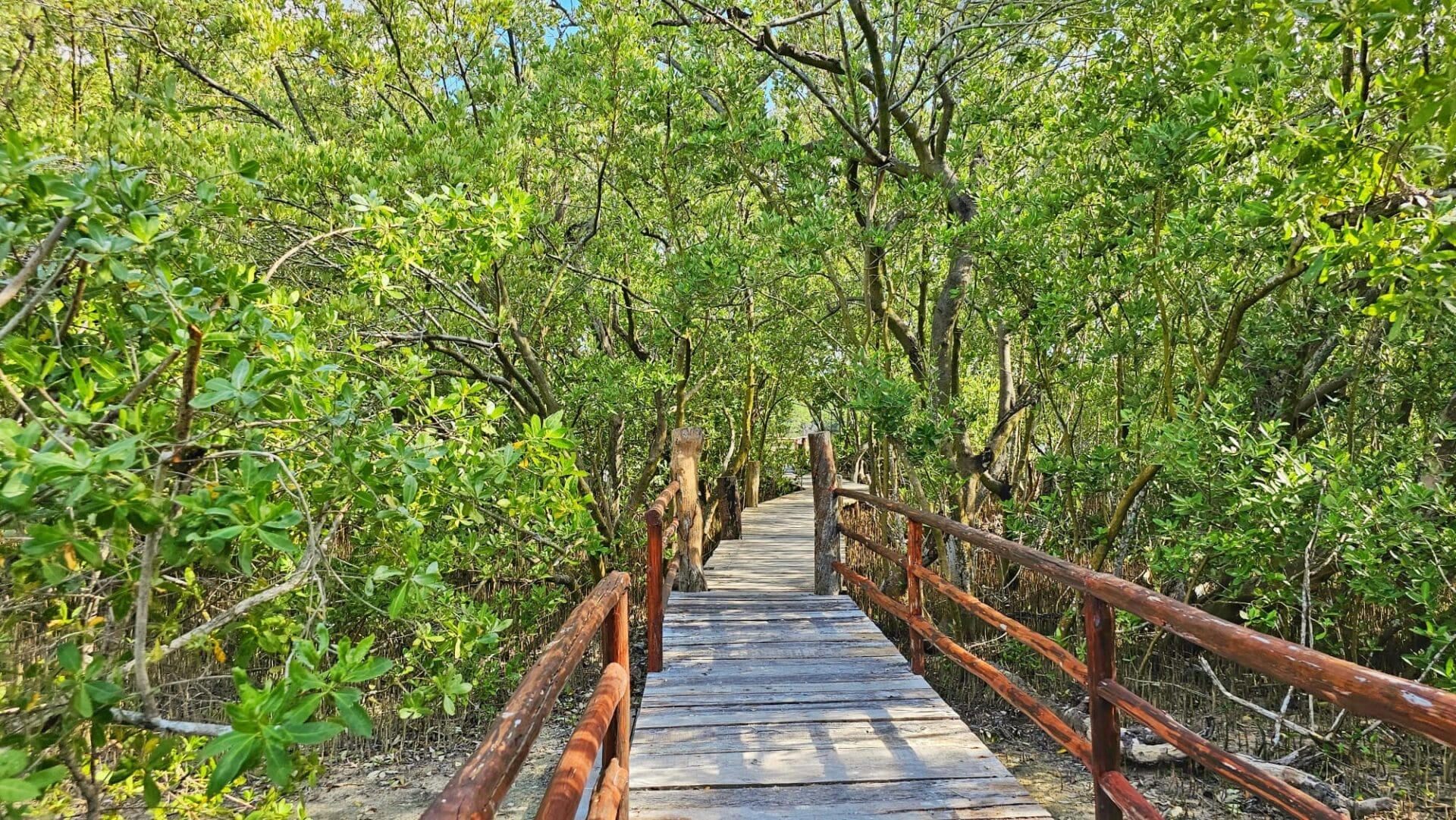
How To Visit Isla Contoy
Isla Contoy is a pristine and protected island located about 30 kilometers north of Cancun.
To visit Isla Contoy, you will need to book a tour with a licensed tour operator as visitors are limited to help preserve the island’s fragile ecosystem.
Here are some steps to help you plan your visit to Isla Contoy:
- Choose a reputable tour operator: Look for tour operators that are licensed to visit Isla Contoy and have good reviews from previous visitors. They will provide transportation to the island, guides, and all necessary permits.
- Book your tour in advance: Due to the limited number of visitors allowed on the island each day, it is recommended to book your tour in advance to secure your spot. Tours typically depart from Cancun or Isla Mujeres (you can also have them pick you up from Playa Del Carmen).
- Enjoy your time on the island: Once you arrive at Isla Contoy, take the time to explore the beautiful white sandy beaches, crystal-clear waters, and diverse marine life. You can also visit the small museum, hike the trails, and enjoy a delicious lunch provided by the tour operator.
Animal Sightings On Isla Contoy
Some of the animals you may see on Isla Contoy include:
- Frigatebirds
- Brown boobies
- Pelicans
- Sea turtles
- Dolphins
- Fish such as snapper, grouper, and barracuda
- Hermit crabs
- Iguanas
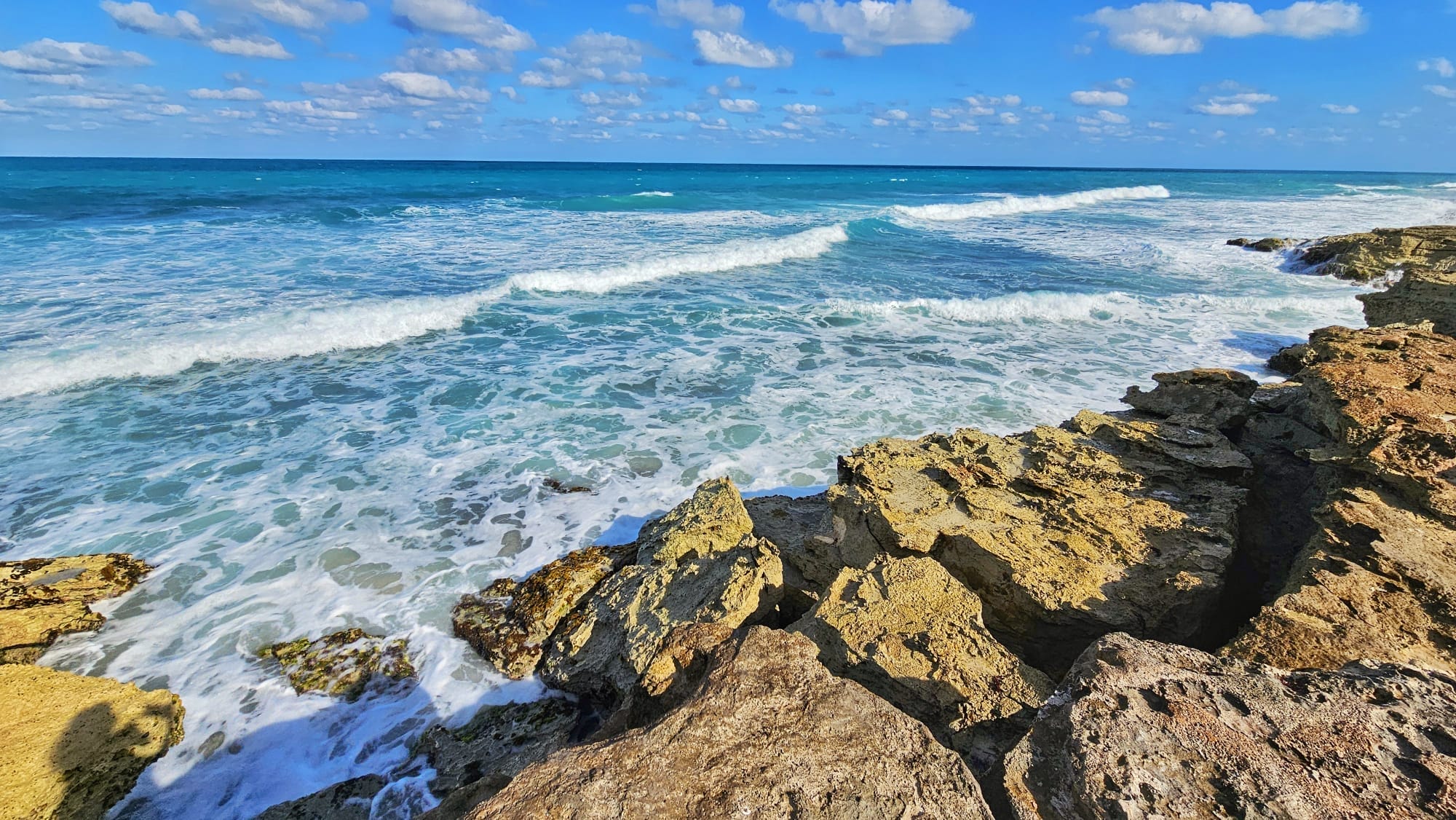
Places To Visit Near Isla Contoy
Near Isla Contoy, you can visit Isla Mujeres, a popular tourist destination known for its beautiful beaches and vibrant nightlife.
You can also explore the nearby Yum Balam Biosphere Reserve, which is home to diverse wildlife and offers opportunities for birdwatching, hiking, and eco-tourism activities.
Additionally, you can visit the underwater sculpture museum in Cancun.
5. XCaret Park: See A Sample Of The Animals In Captivity
While we would recommend you see the beautiful creatures in their natural habitats, for a close-up encounter with wildlife in Cancun, consider visiting XCaret Theme Park.
This eco-archaeological park offers a variety of opportunities to interact with local wildlife, including swimming with dolphins, feeding exotic animals, and observing colorful birds up close.
XCaret is committed to preserving the region’s flora and fauna, making it a great choice for an immersive wildlife experience in Cancun.
The park also offers guided tours and educational programs to learn more about the importance of conservation and biodiversity in the area.
Don’t miss the chance to have a unique and memorable encounter with wildlife at XCaret Theme Park during your visit to Cancun.
Guidelines For Ethical Wildlife Watching In Cancun
When embarking on wildlife adventures in Cancun, it’s essential to follow guidelines for ethical wildlife watching to ensure the well-being and conservation of the animals:
- Respect the natural habitats of the wildlife you encounter, keep your distance and refrain from any actions that may disturb or harm the animals.
- Avoid disturbing the animals, stick to designated pathways, and dispose of your trash properly.
- Support eco-friendly and sustainable tour operators that prioritize the protection of wildlife and their habitats.
- Choose responsible wildlife encounters that prioritize the welfare of the animals and promote conservation efforts in the region.
By being mindful of your actions and choices while observing wildlife in Cancun, you contribute to the preservation of these beautiful animals and their natural environments for future generations to enjoy.
Bring sunscreen, insect repellent, and water: all of these locations can get hot and humid, so make sure to pack sunscreen, insect repellent, and plenty of water to stay comfortable during your visit.
It’s also a good idea to bring binoculars and a camera to capture the stunning landscapes and wildlife in each destination.
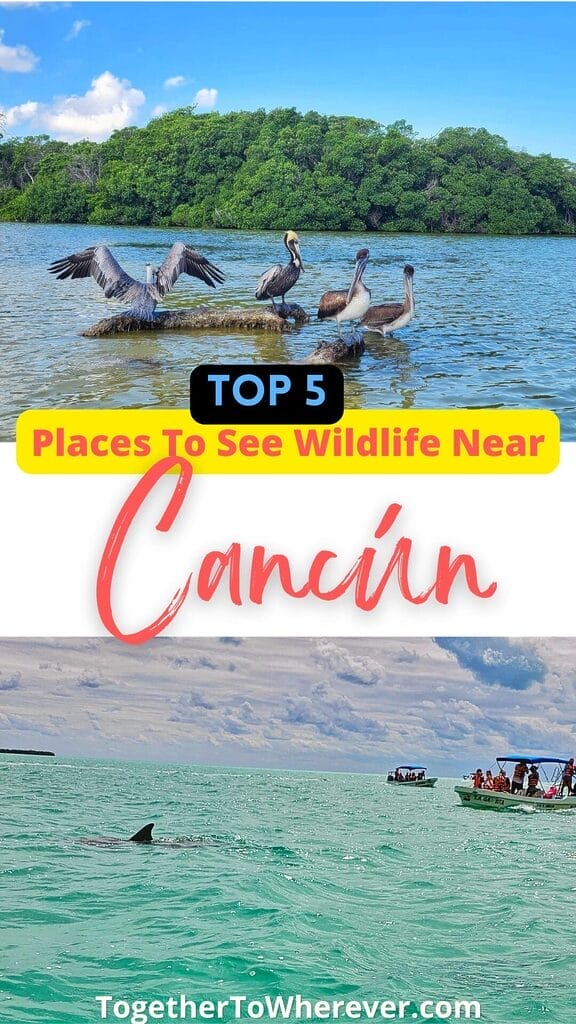


Leave a Reply